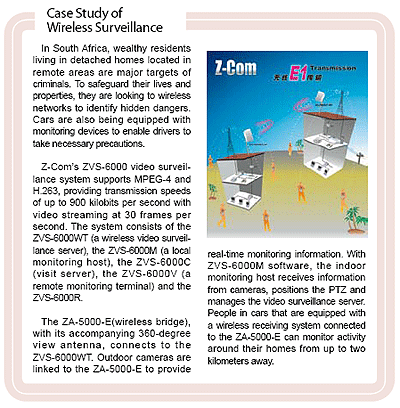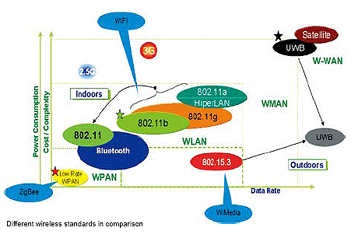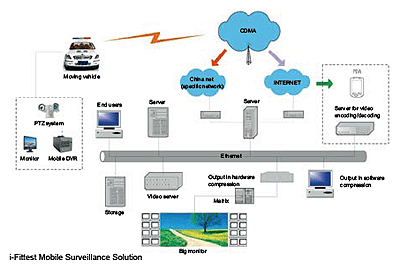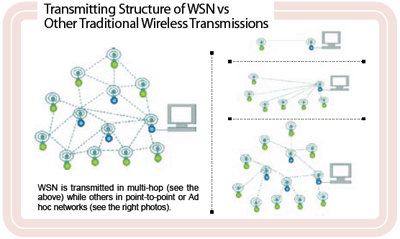Wireless, mobile technologies like WiFi, CDMA, GSM, GPRS, 3G and WiMax are just about set for widespread adoption in video surveillance. In China, however, wireless technology is still regarded as a new technology. A&S looks at developments in China and predicts how Chinese users will benefit.
Wireless, mobile technologies like WiFi, CDMA, GSM, GPRS, 3G and WiMax are just about set for widespread adoption in video surveillance. In China, however, wireless technology is still regarded as a new technology. A&S looks at developments in China and predicts how Chinese users will benefit.
Wired or wireless? The latter benefits from lower cabling costs and simpler installation. As wireless and mobile technologiesWiFi, CDMA, GPRS, 3G and WiMaxdevelop, however, mobile surveillancemobile DVRs (MDVRs) and mobile digital video servers (MDVSs), are becoming hot.
Wireless transmission can be divided into analog and digital transmission. In China, most wireless cameras, especially for home and baby moni tor ing, are analog. Cameras with 2.4-GHz transmission and CMOS sensors constitute the majority; the price is fairly cheap and the products usually work with one wireless monitor and receiver. Other radio frequencies include 1.2, 1.3 and 5.8 GHz. One of the drawbacks of analog is interference from high-voltage electricity in commercial buildings, elevators and information security. Despite this, it remains cost-effective for many non-critical applications.
WiFia collective name of IEEE 802.11a, b, g and n, is still mainstream for wi r e l e s s c ame r a s . Le ading companies are AEE, Lianyida and Goscam. The AEE NC602W network camera is WiFi-compatible, and Lianyida, also launched a few WiFi network cameras embedded with a network video server. Goscam has several wireless network cameras that are WiFi-compatible, ready for export and extra convenient for mobile phone monitoring.
PartIIan early manufacturer of wi reles s cameras - -has expor ted extensively to Japan. "WiFi," said Daniel Chao, Managing Director of PartII, "is a universal wireless standard. In singlechannel transmission, the bandwidth is bigger than CDMA, GSM or GPRS, making it good for video streaming and viewing." PartII started selling wireless cameras in China 10 years ago. Recently, its home surveillance cameras are also selling well in Japan. Other hot markets are Malaysia, Singapore and the U.S.
Wireless cameras for industry or city surveillance are more compatible with multiple wireless LAN standards and mobile technologies, such as WiFi , CDMA, GSM and GPRS. Many high-end products use H.264 compression. Launcha leading IP surveillance product manufacturer sells network cameras and video servers. Its latest H.264 wireless camera views video via WiFi and CDMA as do HuangHe Digital Technology H.264 WiFi and CDMA wireless network cameras.
Meanwhile, Goscam network cameras support WiFi, CDMA and GPRS, and can be used with pocket PC, smart phone and mobile phone monitoring. PartII also has a wireless camera for city surveillance; it transmits video via WiFi, WiMax, CDMA and GSM for mobile surveillance. Adding a boot extends transmission distance to 50 kilometers. Z-Coma R&D-based manufacturer in Nanjingfocuses on wireless LAN products, especially IEEE802.11 WiFi-compatible technology. Z-Com just launched its mobile digital video surveillance solution with MPEG-4 and H.264 for real-time delivery of motion pictures over IP networks. It provides 25 frames per second (PAL) and 30 frames per second (NTSC); bit rates vary from 64 kilobits per second to two megabits per second to provide better quality over limited bandwidth. The application can be used for simple point-to-point architecture or complicated global area network deployment. The solution has also been used in South Africa for wireless surveillance in villas. [Please see the box for further details.]

CDMA Mobile Technology
For mobile devices used in video surveillanceMDVR or MDVSmost vendors use CDMA. WiFi is more suitable for home and small-business surveillance, but if used in city-wide surveillance, it requires more access points. In China, CDMA and GSM have already been certified as standard mobile networking technologies. The two biggest telecommunication providers are China Mobile and China Unicom. China Mobile provides GPRS; China Unicom provides CDMAthe most common technology for mobile surveillance devices in China. Ji Huang, General Manager at I-Fittest pointed out that, so far, the three most popular wireless digital transmission methods for city surveillance are GSM and GPRS, satellite, and CDMA.

GPRS is the most expensive; a single channel provides about 10 to 12 kilobits per second of bandwidthtoo limited for video transmission. CDMA, on the other hand, provides 30 kilobits per second to 70 kilobits per second. It is used widely in China for mobile phone communication as it is cheaper to develop related technologies given the existing public network provided by telecommunication providers. Those with CDMA mobile solutions include EcGuard in Beijing, Woocan.com in Shanghai and I-Fittest in Hangzhou.
I-Fittest has a mobile IP video surveillance solution with unique wireless transmission technology. "In China, mobile devices are just starting to get attention not to mention mobile solutions used for video surveillance. We were one of the first companies to promote the idea of wireless transmission for mobile surveillance solutions," said Huang.

To deliver high-quality images in video surveillance, however, many vendors combine two channels for 60 kilobit per second to 140 kilobit per second bandwidth. While Huang thinks that this is good for video surveillance, there are still too many limitations when it comes to different network environments, especially during heavy network load times.

I-Fittest launched its first mobile surveillance solution, bundling eight channels; this enlarged bandwidth to anywhere from 240 kilobits per second to 560 kilobits per second suitable for video streaming anytime, anywhere. Now, I-Fittest is using the technology in its MDVS with built-in storage. It is well-suited to police and law enforcement applications. It could, for example, be installed in police cars for real-time video streaming and, even, recording.
Other core technologies that Chinese vendors are developing are real-time capture, encoding and decoding technology with MPEG-4 and H.264. Woocam.com has a patented H.264 compression device that enables real-time video streaming over extra-low bandwidth. With single-channel bandwidth at 80 kilobits per second in CDMA1X, it delivers full D1 image quality at 25 frames per second.
To achieve true H.264 real-time streaming, however, I-Fittest has reduced minimum bandwidth to 240 kilobits per second; the product can also self-adjust to different bandwidth and network environments. This could include frame size or speed (down to 10 or 15 frames per second).
Woocan.com's mobile surveillance solution is compatible with CDMA, 3G and IP networks (unicast or multicast) for digital video and audio data streaming and management. It flexibly utilizes available networkswireless or wired - - to achieve the best image quality by swi tching to different networks. Woocan.com products include mobile DVSs used in vehicle or other mobile surveillance. Primary customers include military, law enforcement and public security.
EcGuard, on the other hand, has products that support CDMA2000 1x, but can be easily upgraded to 3G, CDMA, WiFi (802.11b/g) and EDGE. The core technology is wireless video transmission over low bandwidths (under 100 kilobits per second or 60 kilobits per second for high-quality video image transmission that does self-adjusting to suit different network environments). EcGuard has lots of experience in video data streaming encoding and decoding technology, wireless transmission, and embedded OS and software.
Besides flexibility in customization, EcGuard also provides its own transmission security solution. Its law enforcement vehicle surveillance product is a three-in-one system with camera, CDMA and 3G video transmitter as well as providing built-in recording and storage. The portable video surveillance device is a PDA-sized device that is embedded with a helmet camera and mini pinhole camera for real-time video and audio transmission via WiFi, CDMA and 3G as well as on-site recording. Other products are a mobile DVS for mobile surveillance.
3G and WiMax: Waiting for the Big Bang
With IEEE 802.16e increasing in popularity, Motorola and Intel are teaming up to lay the groundwork for the next phase of standardization. In China, the WiMax network infrastructure has been formally implemented in six major cities: Beijing, Shanghai, Tianj in, Wuhan, Hangzhou and Shenzhen. WiMax in China is run by the government instead of telecommunication providers. WiMax (802.16d) supports 512 kilobits per second to three megabits per second, enhancing multi-site surveillance; it is more cost-effective than fiberoptic solutions.

Meanwhile, with the coming of the 2008 Beijing Olympic Games, China Mobile is constructing a mobile system combining GSM, GPRS, EGPRS and TD-SCDMA. The technology combines 2, 2.5, 2.75 and 3 generation telecommunication and also WLAN and WiMax for multimedia transmission via any mobile device.
As an official partner, China Netcom is making online broadcasting of the games a reality; it is doing its utmost to make the Beijing Olympics the first real broadband Olympics featuring barrier-free communications. China Netcom initiated the China Broadband Industry Alliance, together with equipment manufacturers, Internet service providers and content providers as well as international operators, such as Telefonica, PCCW and BT.
In the future, China Netcom aspires to work closely with industry parties, using its National Engineering Lab as a platform and leveraging the Beijing 2008 Olympic Games to promote sustained, healthy development of the broadband industry. It is going to offer one specific IP broadband connection with its network in North America, Southeast Asia, Japan and Korea.
Then, there is China Unicom, which also provides CDMA service and roaming for all international attendees. Products and services delivered during the 2008 Beijing Olympics Games include video and TV viewing via cell phones and video surveillance.
It is predicted that the 2008 Beijing Olympics Games will trigger evolution of wireless transmission technology, especially WiMax. It was believed that, in the near future, WiMax will be the next hot wireless technology, especially in China. Related applications in mobile surveillance should also see upgrades to WiMax.
Wireless Sensor Networks Ready for Development
Wireless sensor networks (WSN) are seeing a major development push. WSN was first developed at the University of California, Berkeley for battlefield surveillance. Recently, it has been adopted by different industries, such as business, health care, surveillance and environmental protection. WSN systems consist of collective network sensor nodes designed to intercommunicate via wireless radio.
A

t one small shopping mall, sensors were installed every 50 meters at entrances as well as inside electronic devicesPOS systems, security guard handheld mobile devices, alarm sensors, lighting systems, CCTV cameras and command centers. All information regarding payment, temperature, customer numbers, security guard location can be displayed on screen; the systems work together with sensors to trigger alarms.
Wireless Sensor Technology, which is located in Shenzhen, developed WSN technology for surveillance as well as building and industrial automation. Its wireless technology is based on IEEE802.15.4 and operates at 2.45 GHz. IEEE802.15.4 is used mostly for wireless personal area networks (WPAN). Advantages are low power consumption (27mA), short-distance radio and low-speed data transmission, and unlimited numbers of sensor nodes (over 65,536). Since WSN is transmitted in multi-hop, every two sensor nodes can serve as transmitters and receivers for communication. This enables the system to receive all information within a very short field of time and respond almost in real time.
The sensors are being packaged in cone-shaped casings with weighted bottoms so antennas will automatically point up. OSD technology transmits data to monitors in real time, adding value to security devices. In addition, security guards no longer see only images but also data displayed on monitors.
Wireless sensor technology has been successfully installed wireless street lamp controllers in Shanghai. These controllers adjust illumination to reduce electricity consumption by 48 percent. The company is also partnering with China Communication Operation & Maintenance to produce the latest in video surveillance solutions.